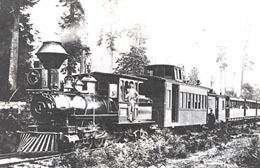 | ||
The Seattle and Walla Walla Railroad (earlier Seattle and Walla Walla Railroad and Transportation Company) was a 3 ft (914 mm) narrow gauge railroad and was the first railroad in Seattle, Washington. Despite its ambitious name, actual construction never went beyond King County, the county of which Seattle itself is the seat.
History
When the Northern Pacific Railway chose nearby Tacoma as its western terminus (1873), many thought that this would condemn Seattle to, at best, a secondary role on Puget Sound. While most of the other towns that were passed over in favor of Tacoma simply accepted their fate, Seattle did not. Selucius Garfielde proposed a railway east through Snoqualmie Pass to the grainfields of Eastern Washington.
The railroad's founding trustees were Arthur Denny, John Collins, Franklin Mathias, Angus Mackintosh, Henry Yesler, James McNaught, J. J. McGilvra, J. M. Colman, and Dexter Horton. They ventured to Walla Walla, where they were given a warm welcome, but lacked Seattle's concern for the project: they already had land transport to Portland, Oregon, not to mention access to the Columbia River.
Nonetheless, construction began on May 1, 1874, at Steele's Landing in Georgetown – the present-day intersection of E. Marginal Way S. and S. Lucille St. – which was then near the mouth of the Duwamish River, later re-channeled and straightened. Twelve miles of track had been completed by October of that year, entirely through volunteer labor by the men of Seattle. The line reached the coal fields of Renton in 1877, with the first train running on March 7.
J. M. Colman, owner of the Seattle lumber mill founded by Henry Yesler, emerged as the leader of the enterprise. He staked US$20,000 of his own money—a fortune in those days, especially during the slow recovery from the Panic of 1873—on the condition that other Seattle businessmen would loan the enterprise at least twice that sum. Colman brought in labor contractor Chin Gee Hee, who organized cheap Chinese labor to continue the construction. (Chin would eventually become a railway entrepreneur in his native China.)
The railroad eventually made it as far as the coal fields of Newcastle, but never attracted the capitalization that would take it anywhere near the city of Walla Walla from which it took half its name.
The Seattle and Walla Walla was bought by Henry Villard's Oregon Improvement Company in 1880 and renamed the Columbia and Puget Sound Railroad. The sale was quite profitable for the line's owners, but did little to connect Seattle to the national land transportation grid. The line was renamed the Pacific Coast Railroad in 1916, which itself became a subsidiary, in 1951, of the Great Northern (now part of the BNSF Railway).
